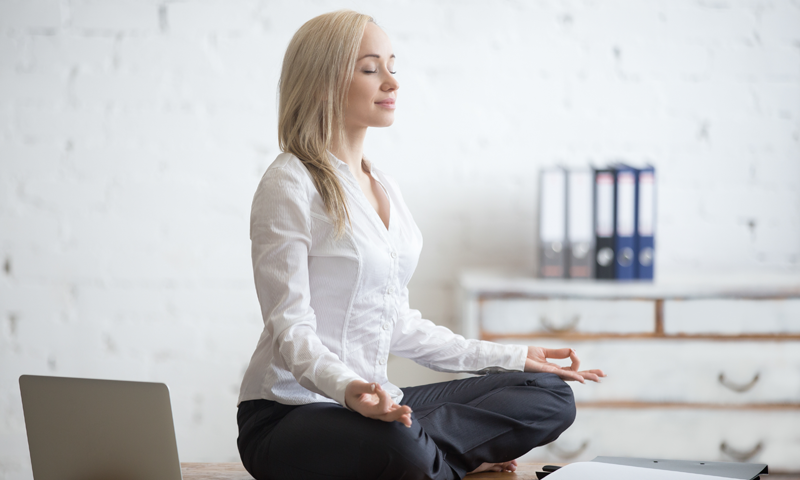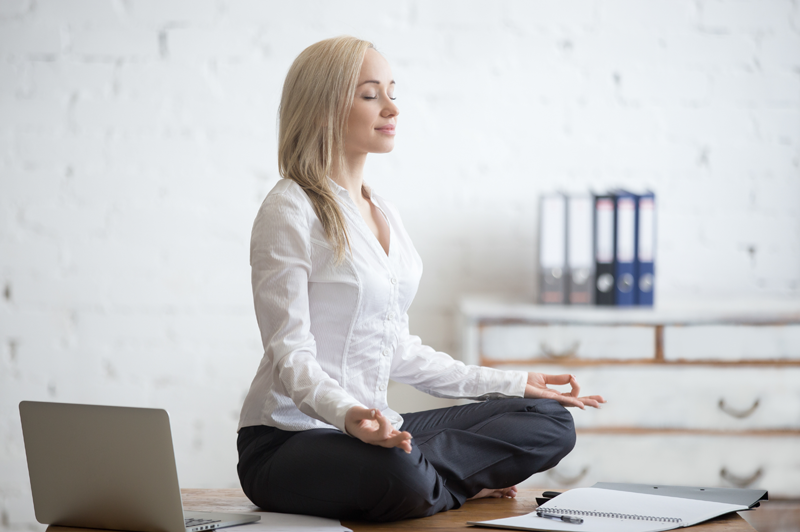
Start your day off right with a morning Yoga Routine
15th February 2017
Get a Yoga Look just like your Favourite Celebrities!
15th February 2017Doing Yoga at Work Can Improve your Health and Productivity

Many of us now spend the majority of our day sitting at a desk and lead a relatively sedentary lifestyle. Sitting at a desk for 8+ hours a day hunched over your computer can lead to overstretching your back and stress on your spine leading to neck, shoulder and lower back pain. Even if you practice yoga a couple of times a week it might not be a match to the stress and tension you’re placing on your body every day at your desk.
Practicing Yoga sequences during work can minimize the effects of being at a desk all day and help improve your physical and mental health; making you more focused, productive and energized.
Yoga is now even actively encouraged by many employers who offer classes within the workplace for employees to take. This has been found by many employers to have a positive impact on both productivity and reduces the amount of time off that employees take off as sick leave.

How can Yoga help improve the workplace?
There are many benefits to Yoga in everyday life including; improving flexibility, weight management, creating inner peace and reducing stress and anxiety. In relation to the workplace there are also a number of ways it can provide benefits for both employers and employees including:
- Relieves stress – Stress costs the UK economy more that £4 billion a year! Yoga can help to alleviate stress and give employees the opportunity to take a moment to relax, stretch and breathe. This time away from their desks allows for some breathing space which can refocus priorities and create a culture of mindfulness.
- Increases productivity – studies have shown that less stressful employees will likely have happier lives and therefore be more productive. They are also less likely to need time off through sickness and ill health.
- Decreases Stress and anxiety- studies have shown that Yoga helps moderate reactions and perceptions of stress allowing employees to deal better with stressful situations.
- Improves mental health – Yoga can help lift depression and has been found to increase levels of a neurotransmitter called GABA which will lift employees moods.
- Improves engagement – If your workplace runs a Yoga class it’s a great opportunity to spend some time with your colleagues doing something non-work related. From an employee perspective this allows you to get to know and build relationships with your co-workers and for employers it’s a great way to encourage people to come together improving communication as a whole in the organisation.
Try these 6 Yoga Poses at Work
If your office doesn’t run a Yoga class or you can’t make it to a class in your lunch break then try these 6 simple poses and add them into your work day. Most of these can be done at your desk and your colleagues probably won’t even notice!
-
- Seated Crescent Moon
This pose allows you to recover from hunching over your desk by lengthening your spine. It also gives you an opportunity to clear your head and breathe.
Simply lift your arms over your head and stretch your fingers. Lean to one side and stay there for 2 or 3 breaths before switching to the other side and repeating
-
- Desk Shoulder Opener
This move is another that counteracts all the hunching that will have happened when sitting at your desk and realigns your shoulders.
Move your chair back from your desk and stand far enough away from your desk so just your hands touch it. Put your head down between your arms and stretch out your shoulders.
-
- Wrist and Finger Stretch
If you’re doing a lot of writing or typing it’s likely that you will build up tension in your hands and wrists. This move will increase blood flow to these areas and doing these moves every couple of hours will avoid that tension building up.
Extend your arms above your head or to your sides and move your arms in a circular motion both inward and outward with your wrists. Then spread your fingers out and wiggle them before closing your fists. To this 5-10 times to shake out the tension. After this place your hands on the desk, palms up and fingers facing you so you can counter stretch your wrists and forearms.
-
- Pigeon Pose
This is great if you usually cross your legs at your desk to help you bring back balance to your hips and lower back.
Sit in your chair with both feet on the floor. Cross your right leg over your left leg at a ninety degree angle with your foot flexed. Spread your weight evenly across your seated position and be sure to stay upright. You’ll then feel a stretch on the outer of your right thigh. Hold for 5 breaths before changing legs and repeating.
-
- Sit and Stand Chair
This pose will help keep your leg muscles active and relieve the pressure sometimes put on your upper back and neck when sitting all day.
Start from sitting with your feet flat on the ground and knees bent at 90 degress. Press your heels into the floor and without moving your feet inward or using the arms of your chair stand up. Once standing slowly begin to sit down again without leaning forward or shifting your weight unevenly. Do this at least 5 times.
-
- Desk Plank
This is a great stretch to counteract all the time you spend sitting every day it will help lengthen your spine and stretch out your hamstrings.
Simply place your hands should width apart or more at the edge of your desk. Then step backwards until your feet are placed under your hips at this point you will start to feel the stretch. Hold this for 10 breaths and really feel the stretch.
Although at first it might feel strange taking the time to do these, the benefits for your physical and mental health are huge and it really is worth taking the 5 minutes to stretch, relax and be mindful.

